As described in the History of Holograms transmission and reflection holograms have different fringe structures so look different.
In the reflection hologram only selected wavelengths (colors) are reconstructed while the transmission hologram diffracts all the wavelengths of light so can it can have a rainbow appearance. The hologram does not change the wavelength (color) of light but controls how light is re-directed.
There are a number of distinct types of art holograms that can be defined by their optical-geometry and the recording medium.
The Denisyuk Reflection Hologram
A Denisyuk hologram is created with a ‘single’ beam’ of laser light that is shone through the hologram surface and then bounces off object back into the hologram surface.
Unless the physical structure is chemically manipulated the reflection hologram will appear the color that it is recorded. To create a true color refection hologram a multiple laser colors are combined – usually a red, green and blue.
Pseudo-color Reflection Hologram
Hologram are images of light, so colors are controlled by selecting and combining spectral colors.
is By manipulating the chemical processing of , the holographic fringe structure can be expanded or shrunk changing the color of the reconstructed image. Pseudo-color reflection holograms can be created through multiple exposures between which the emulsion is swollen or shrunk to shift the recorded fringe spacing and therefore color, a technique that has been used extensively by John Kaufman and Iñaki Beguiristain.
Pseudo-colour Reflection Hologram, 30 x 40 cm
(image courtesy of the artist)

Pseudo-colour reflection hologram, 30 x 40 cm
(via: Inaki Beguiristain)
Laser viewable transmission holograms
The laser viewable transmission hologram allows for a near perfect reconstruction of the optical field. This means that the recorded scene appears behind the film, and when replayed by a laser this scene can be very deep and sharp. These holograms are also used as a master recording that can then be transferred into a reflection or transmission holographic print.
Artist Paula Dawson who has worked extensively with laser viewable transmission holograms describes these recordings as ‘concrete’ holographic images because they create a sense of physical presence.
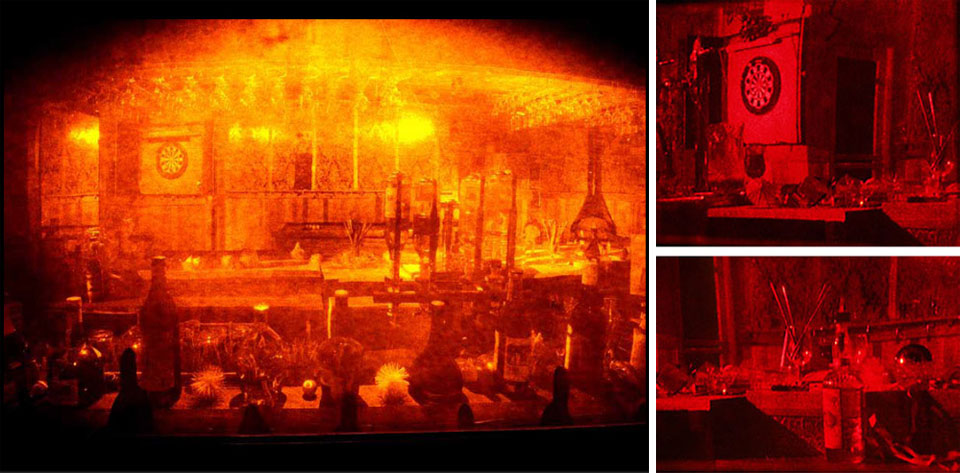
Right: Two perspectives showing the details of the scene from small holograms 4 x 5” (10.2 x 12.7 cm) The Jonathan Ross Hologram Collection
Rainbow Holograms
Transmission holograms have a different a visual quality and the color is controlled by geometry rather than chemistry. When illuminated with a white (broad spectrum) light source the transmission hologram will diffract all the wavelengths of light into the image. However as red-wavelengths are longer, they are deflected more than blue-wavelengths and so the image will have some color smear – the light spreads into a rainbow image.
Sculpture with two rainbow hologram panels on plexiglass 20 x 18″ a Holographic Art Grant Commission printed by John Perry at Holographics North.
A rainbow hologram, recorded from a horizontal master strip and replayed with a light from above, will have horizontal parallax – enabling the spatial qualities when looking with two eyes or moving side-to-side. But moving up-and-down produces no change in spatial perspective and viewer only sees a change of color. By recording a number of masters on an achromatic angle the spectral colors can be recombine to produce images that are whitish (achromatic) or color-mixed (ie, RGB red+green+blue).

Left: Three master strips recorded onto a single piece of film
Right: Three-colour (red, green and blue) multiplex holographic print
Pulse laser holography
Recording a hologram requires the interference pattern to be stationary during the exposure. For this reason holograms are traditionally made of static sculptures on vibration isolated tables. A pulse laser produces an ultra short flash of light, thus freezing motion and allowing for holograms of live subjects.
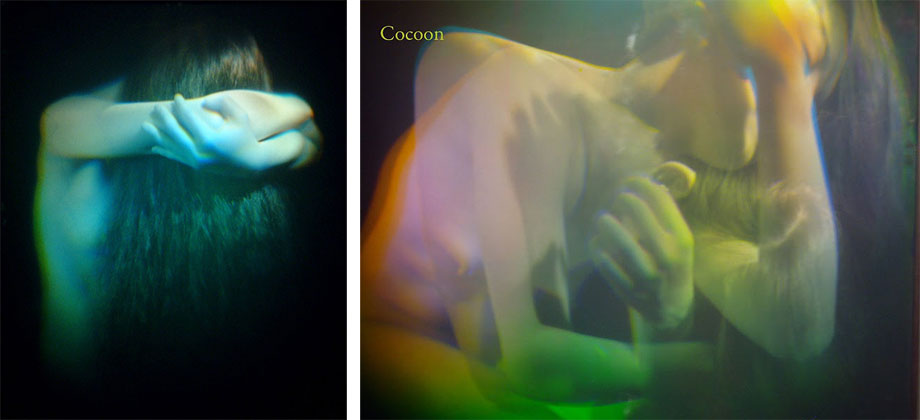
Left: At the Gate, 60 x 50 cm. Right: Cocoon, 50 x 60 cm
Two-color (color mix) reflection holograms from pulse laser masters
(images courtesy of the artist)
Holographic interferometry
As the holographic recording process is dependent on the interference pattern between optical-waves the holographic image is the comparative shape between these waves. Holographic interferometry utilizes this property to detected small variations in form, with applications in industrial non-destructive testing. As part of her ‘Strata Series’ Sally Weber used a holographic interferometry technique – a double laser pulse – to show the movements of breath and blood under the skin.

Open-aperture (laser-viewable), transmission holograms
Left to right: Laccolith, 26 x 27” (66 x 69 cm). Terrain, 18 x 36” (46 x 91 cm). Fossil, 26 x 26” (66 x 66 cm)
The pulse masters were recorded in 2001 at the Center for the Holographic Arts
(via: http://www.sallyweber.com/descent.htm)
Holographic Optical Elements
Holograms can also be used to direct light, which has commercial application in lighting design as well as being used for video projection screens and AR displays6. This property has been incorporated into the process of making holograms by artists. Before the stenciling and digital printing techniques became widely practiced, Rudie Berkhout was creating spatially dynamic holograms using multiple holographic optical elements (HOEs) to shape light into dynamic abstract images. Berkhout’s work explores the optical landscape in relation to a cosmic nature of the perceptual field: “I like the work to oscillate between landscape and abstract painting, challenging viewers and jolting their usual perception of the world.”7
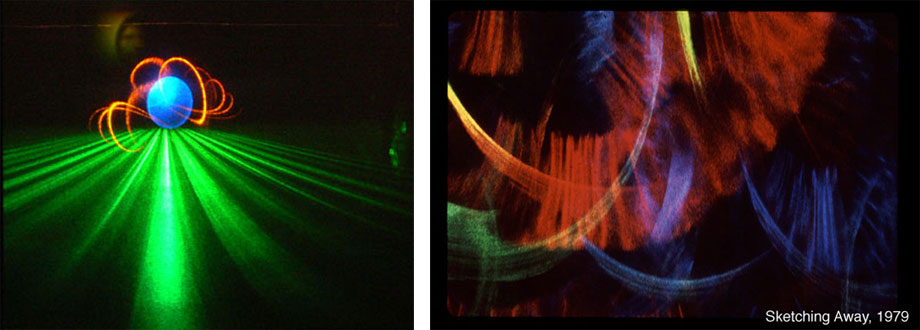
Left: Event Horizon, 1980. 8×10” White-light transmission hologram laminated in 30 x 40 cm
Right: Sketching Away 1979. 8×10” White-light transmission hologram laminated in 30 x 40 cm
(courtesy of the Rudie Berkhout holography collection)
Stenciling and Multiplex holography
Multiplexing is a technique of recording multiple holographic exposures across the surface of the master hologram. By transferring a multiplexed master, a final print can be produced where the ‘virtual windows’ onto the scene is fragmented allowing for spatial animation, stereopsis and depth perception by parallax as the viewer moves around.
Lloyd Cross developed a one step process of recording multiplex holograms in 1972, using a sequence of film frames to make a cylindrical hologram where the image appears in the center. The process combines cinematographic and holographic techniques to display a short animated image loop. By either rotating the cylinder or if the viewer walks around they see the image animated.
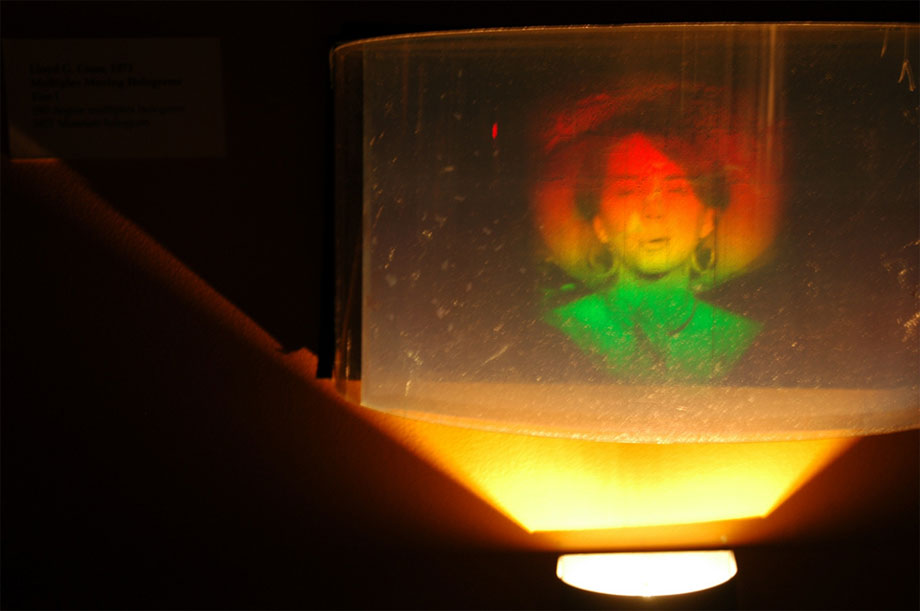
Lloyd Cross and Pam Brazier, The Kiss, 1973
Multiplex hologram, on exhibition at MIT Museum
(image courtesy nsicchia)

Multiplex hologram on film 12 x 23 cm
(via Jonathan Ross Hologram Collection)
Taking a photographic approach to multiplexing Patrick Boyd made a number of multiplex holograms in the early 90s using a process of hand animation with image slides and stencils over the hologram. He describes the duration enfolded within his multiplex holograms – “The work is essentially an interactive experience for the viewer, but during which he remains in control, deciding for himself the speed with which the image is revealed and explored, frame by frame.”8

Reflection multiplex hologram, 8.5 x 9” (21.6 x 22.9 cm)
Three photographs of the hologram at MIT Museum, 2008
By dividing the holographic window into small exposure regions, multiple 2-d images can be used to synthesize a 3D scene or record an animation.
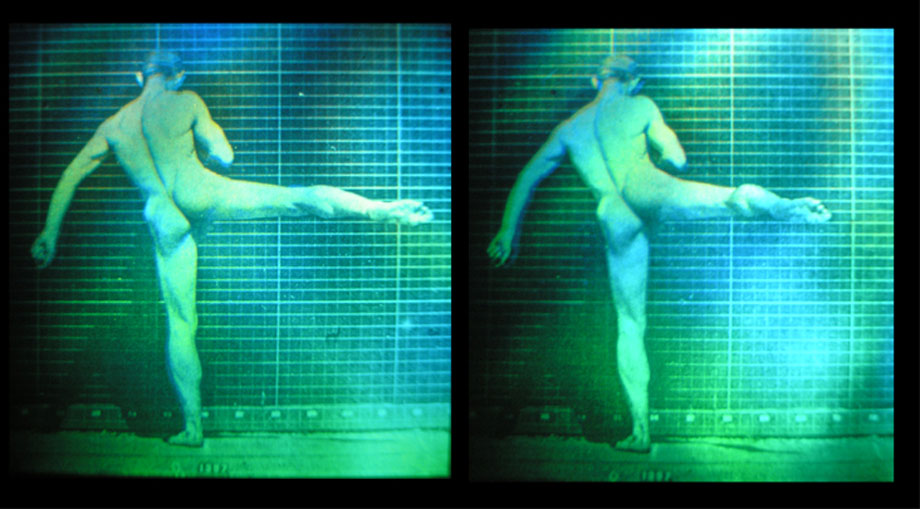
From photographs by Eadweard Muybridge
Mirror-backed achromate white-light transmission, multiplex hologram 10 x 8″ (25.4 x 20.3 cm)
“The stereo should be viewed with the images no larger than a post-it note (62 mm between similar image points) as the hyper-parallax, caused by the fusion of temporal and stereoscopic parallax (the extended right foot) is really hard to fuse in this pair”, from email instructions from David Pizzanelli that accompanied the image, 2010.
The multiplexing process can also be consider as a means of optically stencilling different images into a scene. Brigitte Burgmer’s hologram ‘Future Perfect’ was created by masking the master recording in some places leaving only a tiny window so that artifacts can only be seen from a very particular position. A negative of the mask was then applied to a flipped master, filling in the voids with a pseudoscopic9 view of the scene. Burgmer describes this diptych as “visually very complex and a challenge for perception”.10

Reflection holograms 32 x 43 cm
(image courtesy of Sammlung Lauk (Lauk Collection)
Dot-matrix holograms
Dot-matrix hologram printing is a technique of building up an image of diffractive ‘pixels’. Each area is recorded with a particular geometry that diffracts light by a corresponding angle. The illuminating light is deflected into varying divergent colour-spectrums. The image is a tiling of colours which means the images are very bright but do not have 3-d depth information. Dot-matrix holograms have been used as a means of decorative ‘light architecture’. Michael Bleyenberg defines ‘light architecture’: “This term indicates a vision: to ‘plan and construct’ environments beyond everyday perception and experience, barely tangible, not using solid material, but the ephemeral medium light.”11
EyeFire/AugenFeuer, 2000. German Research Association(DFG) building in Bonn, 13 x 5 m;
Close of EyeFire/AugenFeuer;
Computer generated ‘digital’ holography
With computer generated ‘digital’ holograms the fringe pattern of each pixel is calculated and recorded into the hologram. There are a number of ways of making digital holograms in which small regions of the film, termed ‘Voxels’ or ‘Hogels’, are exposed to the pre-calculated fringe pattern, such as by using a spatial light modulator (SLM) or electron beam lithography. In early systems these Hogels were noticeable causing the surface of the hologram to look pixelated.
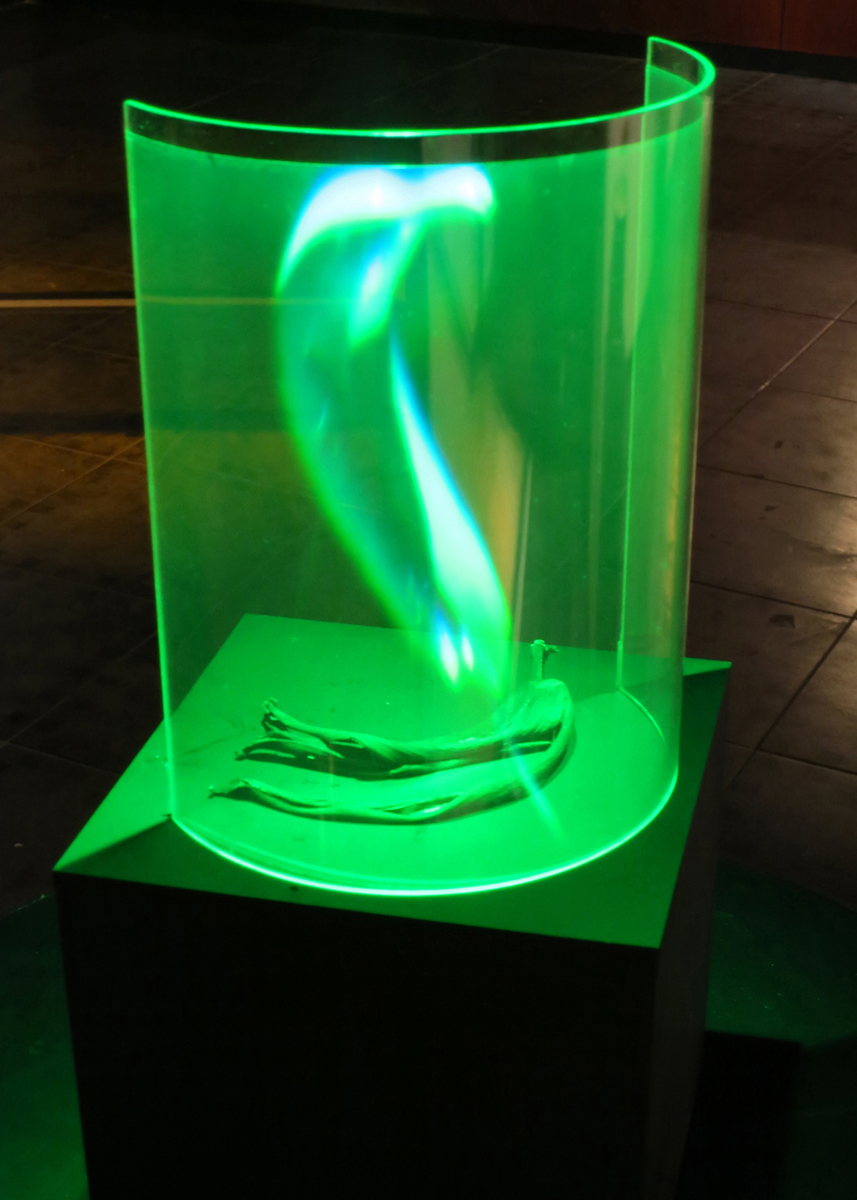
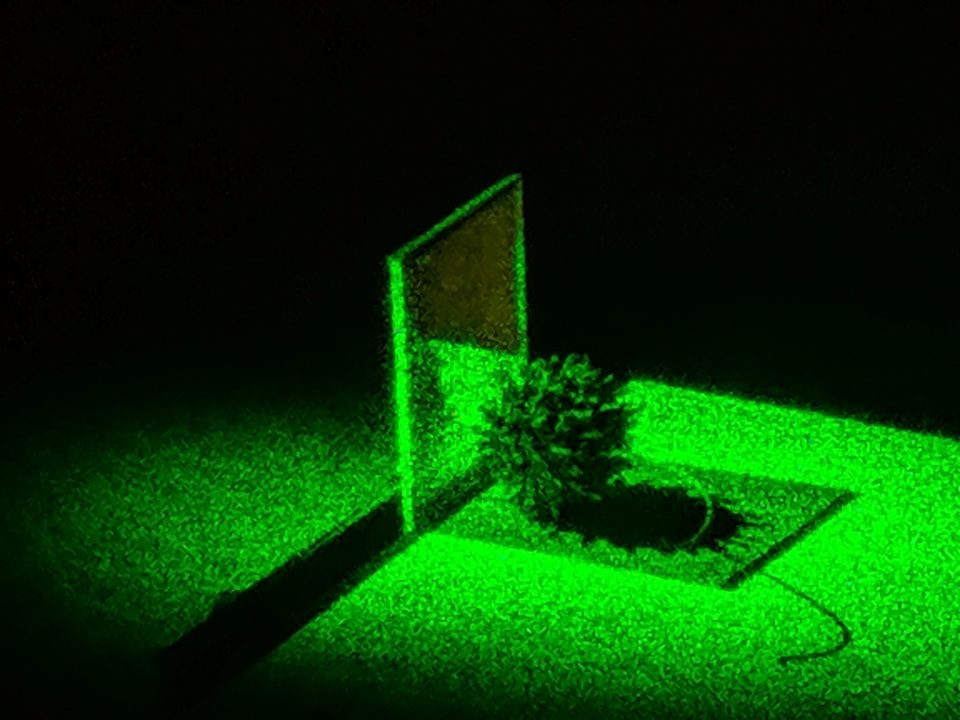



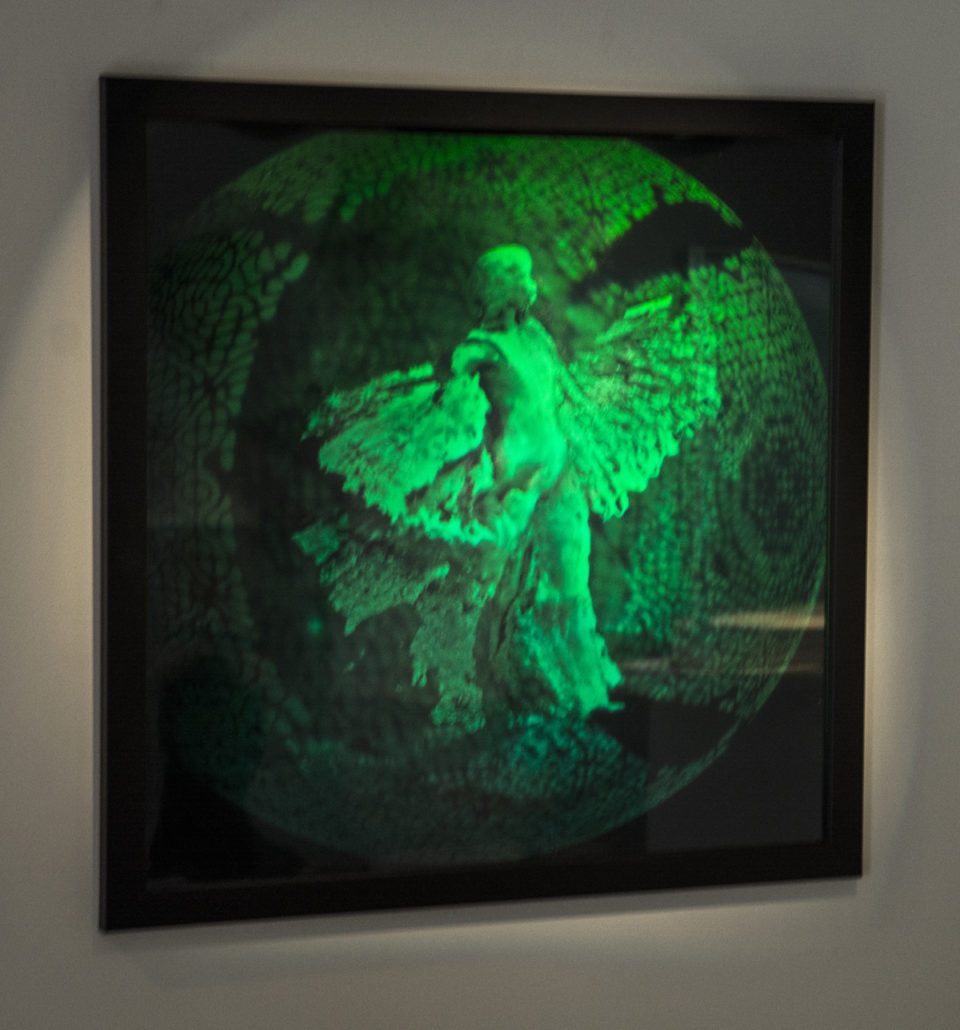

 A history of the future of holographic art
A history of the future of holographic art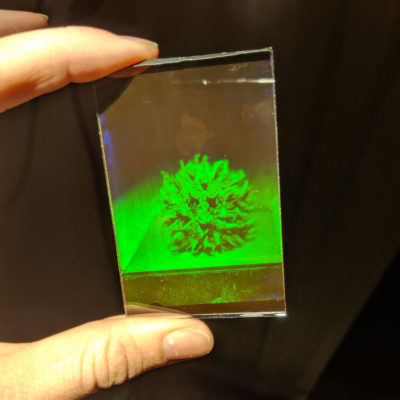 What is a Hologram?
What is a Hologram?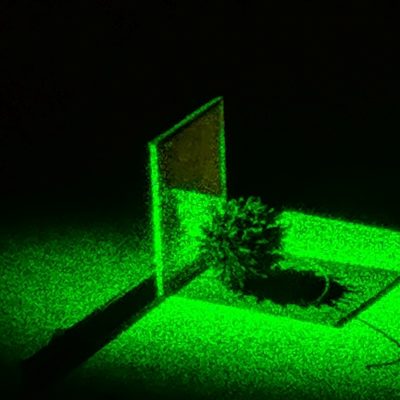 How are images recorded in a hologram?
How are images recorded in a hologram?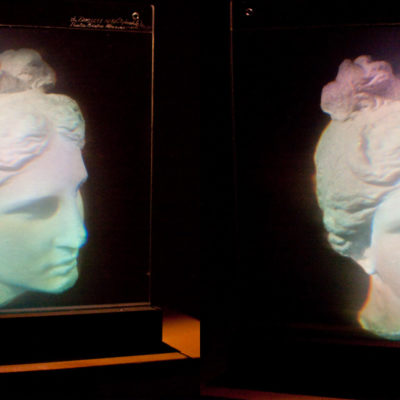 History of Holograms
History of Holograms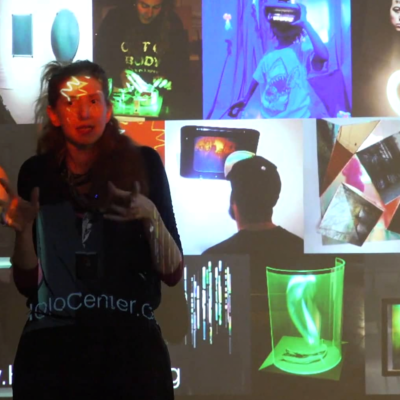 What is Holographic Art
What is Holographic Art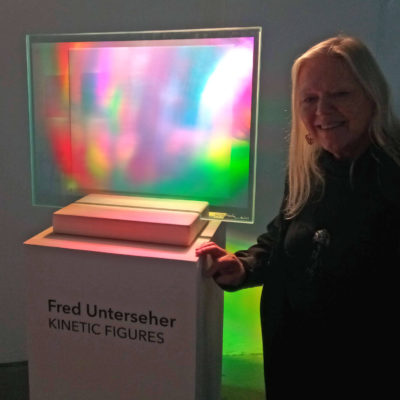 HoloSeminars
HoloSeminars